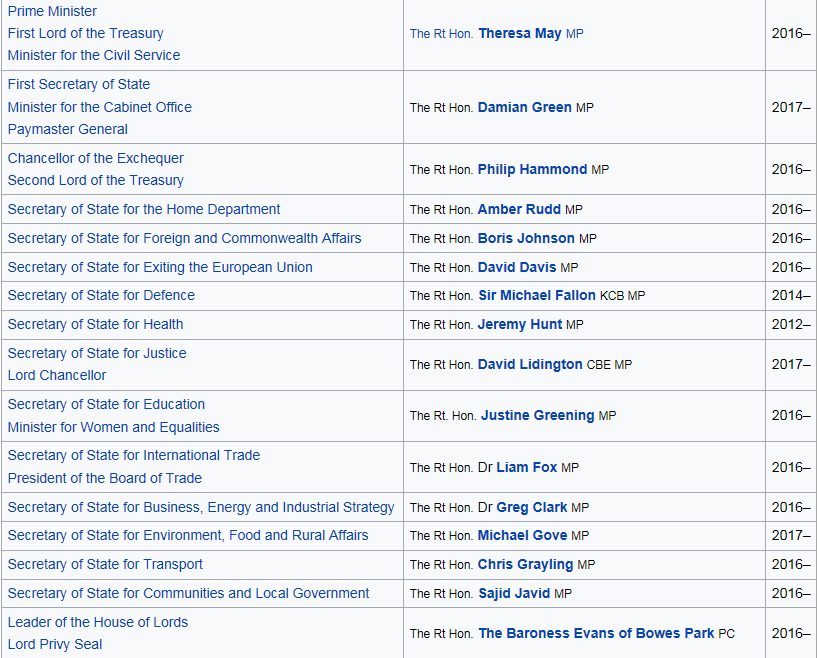Prime Minister & Cabinet
Key Terms
Executive: branch of government responsible for implementing (‘executing’) legislation. The executive includes the government and the civil service
Prime Minister: the head of government (but not head of state)
Cabinet: a formal committee of leading government members, including heads of government departments
Kitchen cabinet: an informal group of advisers consulted by the PM, which may include some cabinet members and individuals outside of the cabinet
Core executive: the informal network of individuals and groups who are involved with policy-making. Who is in the core executive depends on the PM, but will usually include the PM themselves, key members of the cabinet, senior officials from government departments and possibly outside bodies such as intelligence services, key MPs such as whips, and policy advisers the PM chooses to consult with
Prime Minister
In theory, anyone can become prime minister (as the Queen appoints the PM). In practice, they need to be an MP (so at least 18 years old, and a UK or Commonwealth citizen); a party leader; and the leader of the party who has a majority in the Commons. Sometimes PMs become PMs not through an election but because they become the leader of the majority party (for example, Gordon Brown, Theresa May). Sometimes party leaders become prime minister without having an overall majority (for example, David Cameron in 2010 and Theresa May in 2017).
The prime minister has the following roles:
- To appoint government ministers to a cabinet
- To direct and influence government policy- this includes all areas of policy but is usually focused on the main areas of economics and foreign policy
- To manage the cabinet, for example deciding when and how long to meet for and setting the agenda for discussion
- To organise the government, for example, government departments and how they are set up
- To control Parliament (by having a majority in the Commons)
- To provide leadership, for example in response to major events
The prime minister’s role has grown and developed over time, as there is no codified constitution setting out the ‘official’ role and significance. In theory, the PM is ‘primus inter pares’ (first among equals), as they have an equal say in cabinet policy discussion, but are the primary representatives of the government. In practice, modern PMs can be argued to be more significant than this, perhaps resembling US Presidents in terms of power and influence.
Cabinet
The cabinet is made up of around 20 members of the government, most of whom run departments, for example, the Treasury, the Home Office, the Foreign Office and so on. It meets every Wednesday morning, usually for less than two hours. There is a ‘hierarchy’ of importance within the cabinet, the most important posts being Chancellor, the foreign secretary, home secretary and deputy prime minister (although a deputy PM is not always appointed).
The cabinet has the following roles:
- Approving policy- even though policy is usually more meaningfully discussed elsewhere
- Coordinating policy, for example making all ministers aware of policy decisions and progress in all government departments
- Resolving disputes and disagreements between ministers, if necessary
- Debating and discussing issues
- Considering the views of the party MPs (the parliamentary party)
- Promoting collective responsibility
Example: extract from Theresa May’s cabinet (June 2017, wikipedia.org)
Ministers oversee the work of, and run, the various government departments. They work with civil servants, who are not in the cabinet (although very senior and experienced civil servants may be asked to attend cabinet meetings). Secretaries of state are the most senior ministers, followed by ministers of state (who are not in the cabinet), parliamentary under-secretaries of state (often referred to as junior ministers), and finally parliamentary private secretaries (PPSs), who are not paid for this role, but work with more senior ministers. PPSs are not members of the government but would vote with the government when it comes to legislation- this is part of the so-called ‘payroll vote’.
Civil servants work with ministers to implement government policy. They are permanent (their position does not change with governments), neutral (expected to be loyal to whatever party is in power) and anonymous (they are not known publically, as they are not ultimately responsible for policy). Although in practice, there were concerns in the past that the civil service had too much power. It was argued that ministers would only make a few policy decisions, and relied heavily on civil servants for advice and information (satirised in the sitcom Yes, Minister). They were also thought to be possibly politically biased in favour of the Conservative Party. Therefore, efforts have been made to provide ministers with alternative sources of information, from example independent advisers and think-tanks. It is now argued that maybe the civil service has too little power.
In addition, ‘executive agencies’ exist. These are best described as semi-independent from the government. They carry out some functions of government departments, for example the DVLA carries out functions of the Department for Transport, by issuing licences, penalty points, registering vehicles, and so on.
